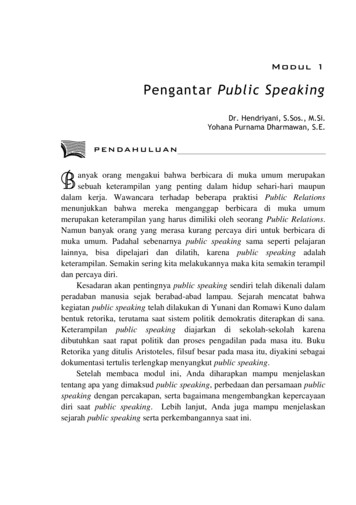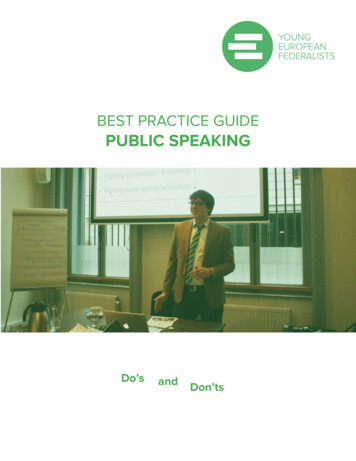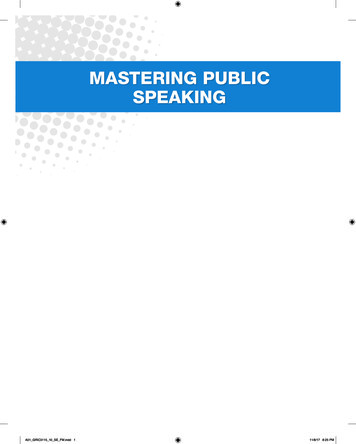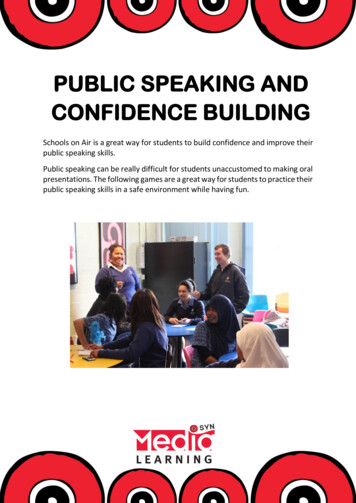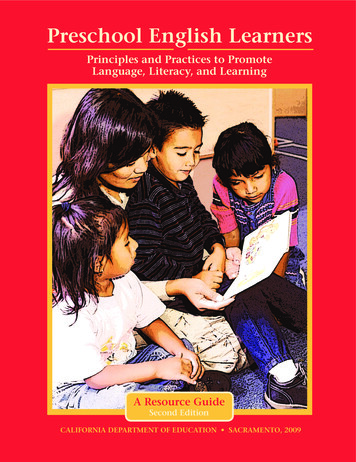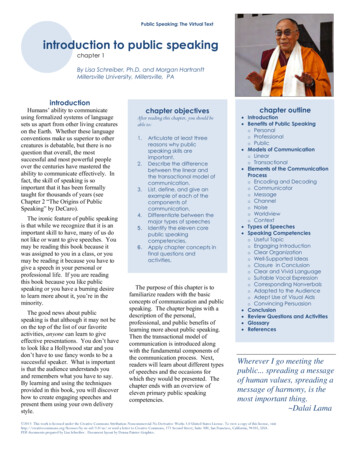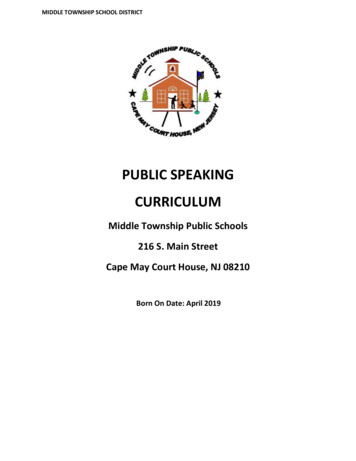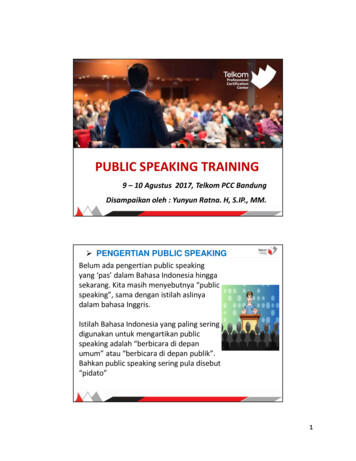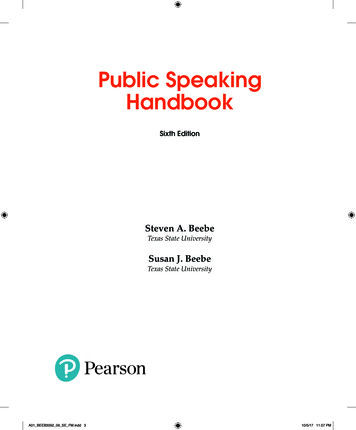
Transcription
Public SpeakingHandbookSixth EditionSteven A. BeebeTexas State UniversitySusan J. BeebeTexas State UniversityA01 BEEB3092 06 SE FM.indd 310/5/17 11:07 PM
Director, Portfolio Management: Karon BowersContent Producer: Barbara CappuccioContent Developer: Ellen KeohanePortfolio Manager Assistant: Dea BarbieriProduct Marketer: Christopher BrownField Marketer: Kelly RossContent Producer Manager: Melissa FeimerContent Development Manager: Sharon GearyManaging Editor: Maggie BarbieriContent Developer, Learning Tools: Amy WetzelArt/Designer: Kathryn FootDigital Studio Course Producer: Amanda SmithFull-Service Project Manager: SPi GlobalCompositor: SPi GlobalPrinter/Binder: LSC Communications, Inc.Cover Printer: Phoenix Color/HagerstownCover Designer: Lumina Datamatics, Inc.Cover Credit: Cover illustration by Greg Betza,www.gregbetza.com.Credits and acknowledgments borrowed from other sources and reproduced, with permission, inthis textbook appear on the appropriate page of appearance or in the Credits on pages 439–444.Copyright 2019, 2016, 2013 by Pearson Education, Inc. or its affiliates. All Rights Reserved.Printed in the United States of America. This publication is protected by copyright, and permissionshould be obtained from the publisher prior to any prohibited reproduction, storage in a retrievalsystem, or transmission in any form or by any means, electronic, mechanical, photocopying, recording, or otherwise. For information regarding permissions, request forms and the appropriatecontacts within the Pearson Education Global Rights & Permissions department, please visit www.pearsoned.com/permissions/.PEARSON, ALWAYS LEARNING, and Revel are exclusive trademarks in the U.S. and/or othercountries owned by Pearson Education, Inc. or its affiliates.Unless otherwise indicated herein, any third-party trademarks that may appear in this work are theproperty of their respective owners and any references to third-party trademarks, logos or othertrade dress are for demonstrative or descriptive purposes only. Such references are not intendedto imply any sponsorship, endorsement, authorization, or promotion of Pearson’s products by theowners of such marks, or any relationship between the owner and Pearson Education, Inc. or itsaffiliates, authors, licensees or distributors.Library of Congress Cataloging-in-Publication DataNames: Beebe, Steven A., author. Beebe, Susan J., author.Title: Public speaking handbook / Steven A. Beebe, Susan J. Beebe.Description: Sixth edition. Boston : Pearson, [2017] Previous edition:2016.Identifiers: LCCN 2017033201 ISBN 9780134623092 ISBN 0134623096Subjects: LCSH: Public speaking. Oral communication.Classification: LCC PN4129.15 .B44 2017 DDC 808.5/1—dc23 LC record available athttps://lccn.loc.gov/2017033201118ISBN 10:0-13-462309-6ISBN 13: 978-0-13-462309-2A01 BEEB3092 06 SE FM.indd 410/5/17 11:07 PM
Dedicated to our parents,Russell and Muriel Beebeand Herb and Jane Dyeand to our children,Mark, Amanda, and Matthew BeebeA01 BEEB3092 06 SE FM.indd 510/5/17 11:07 PM
A01 BEEB3092 06 SE FM.indd 610/5/17 11:07 PM
ContentsPrefacePart 11xiIntroductionIntroduction to PublicSpeaking1.1 What Is Public Speaking?1.2 Why Study Public Speaking?QUICK CHECK Why Study PublicSpeaking?1.3 The Communication Process411.4 The Rich Heritage of Public Speaking82QUICK CHECK The Rich Heritageof Public Speaking10Speaking with Confidence132.1 Understand Your NervousnessHOW TO Make Your Understandingof Anxiety Work for YouQUICK CHECK Understand YourNervousness152.2 How to Build Your Confidence18HOW TO Channel Your Energy20HOW TO Get and Give Supportin Public-Speaking Class22QUICK CHECK Build Your Confidence23Presenting Your First Speech2533.1 Consider Your Audience3.2 The Audience-Centered SpeechmakingProcessHOW TO Pick a Speech TopicHOW TO Incorporate an Oral Citationinto Your SpeechQUICK CHECK The Ethical PublicSpeaker 4.3 Speaking CrediblyPart 2529HOW TO Develop and Use a SpecificPurpose30HOW TO Identify the Main Ideasin Your Speech314647525353Analyzing an AudienceListening to SpeechesListening5760HOW TO Prevent Listener Fatigue61HOW TO Minimize Outside Distractions63HOW TO Counteract Prejudice635.2 How to Become a Better ListenerHOW TO Become an Active Listener64695.3 Improving Critical Listeningand Thinking SkillsQUICK CHECK Critical Thinkingand Listening5.4 Analyzing and Evaluating Speeches2628435.1 Overcoming Barriers to Effective1617Speaking Freely and Ethically 414.2 Speaking Ethically4837QUICK CHECK History of Free Speechin the United States4QUICK CHECK The CommunicationProcess33SAMPLE SPEECH Cinderella by GraceHildenbrand4.1 Speaking Freely23SAMPLE OUTLINEQUICK CHECK Giving Good Feedback6Analyzing Your AudienceHOW TO Become an AudienceCentered Speaker7072727781846.1 Gathering Information about YourAudienceHOW TO Develop a Survey8487viiA01 BEEB3092 06 SE FM.indd 710/5/17 11:08 PM
viii Contents6.2 Analyzing Information about YourAudienceQUICK CHECK Analyzing AudienceInformation8.2 Research Strategies14187HOW TO Take Effective Notesfrom Your Sources14289QUICK CHECK Research Strategies1426.3 Adapting to Your Audience6.4 Analyzing Your Audience89before You Speak90QUICK CHECK Select Effective Statistics 150HOW TO Use Diverse Strategies98QUICK CHECK Adapting to DiverseListenersQUICK CHECK Types of SupportingMaterial99QUICK CHECK The Speaking SituationHOW TO Use Illustrations EffectivelyQUICK CHECK Customizing YourMessage1031076.6 Analyzing Your Audienceafter You SpeakQUICK CHECK Ways to Analyze YourAudience after SpeakingPart 377.1 Select and Narrow Your Topic111113117QUICK CHECK Selecting a Topic118HOW TO Narrow Your Topic119120HOW TO Formulate Your SpecificPurpose Statement121HOW TO Determine Your Main IdeasMEANWHILE, BACK AT THECOMPUTER . . .Gathering and UsingSupporting Material8.1 Sources of Supporting Material9145151152123126133134Organizing and OutliningYour SpeechQUICK CHECK Primacy, Recency,and Complexity155157159QUICK CHECK Organizing YourMain Points1649.2 Organizing Your Supporting Material165QUICK CHECK Organizing YourSupporting Material1689.3 Organizing Your Presentationfor the Ears of Others: SignpostingQUICK CHECK Types of Signposts9.4 Outlining Your Speech10171171176SAMPLE PREPARATION OUTLINE176QUICK CHECK Two Types of SpeechOutlines180Introducing Your SpeechQUICK CHECK Does Your IntroductionAccomplish Its Purpose?10.2 Effective Introductions11168HOW TO Evaluate Your Speech UsingYour Preparation Outline10.1 Purposes of Introductions126129Crafting a Speech9.1 Organizing Your Main Ideas119QUICK CHECK General Purposesfor Speeches7.3 Develop Your Central Idea7.4 Generate and Preview Your Main IdeasPart 4108HOW TO Brainstorm for a Topic7.2 Determine Your Purpose8107Preparing a SpeechDeveloping Your Speech8.4 The Best Supporting Material1421036.5 Adapting to Your Audience as YouSpeak8.3 Types of Supporting Material183185188188HOW TO Deliver an Opening Question192QUICK CHECK Effective Introductions194Concluding Your Speech11.1 Purposes of Conclusions197198HOW TO Find and Use OnlineDatabases138HOW TO Signal the End of Your Speech 200QUICK CHECK Supporting Materialin the Library140QUICK CHECK Purposes of YourSpeech ConclusionA01 BEEB3092 06 SE FM.indd 820110/5/17 11:08 PM
Contents11.2 Effective ConclusionsQUICK CHECK Effective Conclusions12Using Words Well: SpeakerLanguage and Style201QUICK CHECK Oralversus Written Style20720812.2 Using Words Effectively12.3 Adapting Your Language Style208to Diverse Listeners211HOW TO Avoid Sexist Language12.4 Crafting Memorable Word StructuresPart 513Delivering Your SpeechQUICK CHECK The Power of SpeechDelivery13.2 Methods of Delivery222224275277Understanding22713.3 Characteristics of Effective Delivery228HOW TO Use Eye Contact Effectively230HOW TO Gesture Effectively231QUICK CHECK Characteristics of GoodVocal Delivery239HOW TO Use a Stationary Microphone24013.4 Rehearsing Your Speech: Some Final Tips 24113.5 Delivering Your Speech24313.6 Responding to Questions245Using Presentation Aids14.1 Types of Presentation Aids251253QUICK CHECK Types of Presentation Aids 26314.2 Using Computer-GeneratedPresentation Aids26314.3 Guidelines for Developing281HOW TO Enhance Message Clarity282HOW TO Paint a Word Picture284QUICK CHECK Enhancing AudienceUnderstanding28515.3 Strategies to Maintain Audience Interest 285HOW TO Tell a Good Story287SAMPLE INFORMATIVE SPEECH Choosinga Speech Topic by Roger Fringer288QUICK CHECK Keeping the AudienceInterested28915.4 Strategies to Enhance Audience Recall290QUICK CHECK Enhancing Audience Recall 29215.5 Developing an Audience-CenteredInformative Speech224HOW TO Give an ImpromptuPresentationTypes of SpeechesSpeaking to Inform21322127215.1 Informative Speech Topics15.2 Strategies to Enhance AudienceDelivering a Speech13.1 The Power of Speech Delivery1415213QUICK CHECK Adapting Your LanguageStyle to Diverse Listeners213268QUICK CHECK Guidelines for UsingPresentation Aids205 Part 612.1 Differentiating Oral and WrittenLanguage Styles14.4 Guidelines for Using Presentation Aids202ix292QUICK CHECK Audience-CenteredInformative Speaking16Understanding Principlesof Persuasive Speaking29429716.1 The Goals of PersuasionQUICK CHECK Goals of Persuasion16.2 How Persuasion WorksQUICK CHECK Models of Persuasion16.3 How to Motivate Listeners299301302305305HOW TO Use Cognitive Dissonanceto Persuade307QUICK CHECK Coping with CognitiveDissonance309QUICK CHECK Using Fear AppealsEffectively31316.4 How to Develop Your Audience-CenteredPersuasive Speech314266HOW TO Pick a Persuasive SpeechTopic316QUICK CHECK Guidelines for DevelopingPresentation Aids268QUICK CHECK Audience-CenteredPersuasive Speaking322Presentation AidsA01 BEEB3092 06 SE FM.indd 910/5/17 11:08 PM
x Contents17Using Persuasive Strategies17.1 Enhancing Your Credibility17.2 Using Reasoning and EvidenceHOW TO Test the Validity of InductiveReasoning325 Part 7326329334QUICK CHECK Avoid These Fallacies341QUICK CHECK Tips for Using Emotionto PersuadeHOW TO Correct an Audience’sMisconceptions34534634917.5 Strategies for Organizing PersuasiveMessages350SAMPLE PERSUASIVE SPEECH You AreWhat You Eat: Why You Should EatGrass-Fed Organic Beef by Colter Ray35118Speaking for Special Occasionsand Purposes36318.1 Public Speaking in the WorkplaceQUICK CHECK Tips for SuccessfulGroup Presentations18.2 Ceremonial Speaking383384QUICK CHECK Steps in Problem SolvingA.2 Participating in Small GroupsA.3 Leading Small GroupsQUICK CHECK Characteristicsof Effective Leaders34217.4 Strategies for Adapting Ideas to Peopleand People to IdeasSpeaking in Small GroupsA.1 Solving Problems in Groups and Teams331HOW TO Test the Truth of a DeductiveArgument17.3 Using Emotional AppealsA365368370HOW TO Present an Award372HOW TO Accept an Award374QUICK CHECK Types of CeremonialSpeeches376AppendixesBSpeeches for Analysisand Discussion388388390392393I Have a DreamMartin Luther King Jr.393Inaugural AddressJohn F. Kennedy394Second Inaugural AddressBarack Obama396Remarks to the U.S. CongressPope Francis400The Need for Minority Bone Marrow DonorsJulio .3 After-Dinner Speaking: UsingHumor EffectivelyA01 BEEB3092 06 SE FM.indd 1037710/5/17 11:08 PM
PrefaceThe Public Speaking Handbook, Sixth Edition, is anadaptation of the successful tenth edition of PublicSpeaking: An Audience-Centered Approach. The distinguishing focus of the book remains our audiencecentered approach. As in the development of theprevious editions, we have listened to students andinstructors to make the sixth edition an even moreuseful tool to help students improve their publicspeaking abilities. The goal of this edition of the Public Speaking Handbook is to be a practical and friendlyresource to help students of public speaking connecttheir hearts and minds with those of listeners. Available both in Revel as well as in its traditional spiralbound format, this new edition of the Public SpeakingHandbook is audience-centered in its own right: itencourages students to become more involved intheir own learning process.Special Features for Public Speaking StudentsRevel is a dynamic learning experience that offersstudents a way to study the content and topicsrelevant to communication in a whole new way.Rather than simply offering opportunities to readabout and study public speaking, Revel facilitatesdeep, engaging interactions with the conceptsthat matter most. For example, in Chapter 3, students are presented with the authors’ hallmarkaudience-centered model as an interactive figure diagramming the various tasks involved inthe speechmaking process. This figure is usedthroughout the text to emphasize the importanceRevel Revel is an interactive learning environment thatdeeply engages students and prepares them forclass. Media and assessment integrated directlywithin the authors’ narrative lets students read,explore interactive content, and practice in onecontinuous learning path. Thanks to the dynamicreading experience in Revel, students come toclass prepared to discuss, apply, and learn frominstructors and from each other.Learn more about Revelwww.pearson.com/revelxiA01 BEEB3092 06 SE FM.indd 1110/5/17 11:08 PM
xii Prefaceof being audience-centered. Throughout chaptersin Revel students can interact with this figure tolearn more about each stage of the process. Inthe Chapter 15 Study Guide they can take a selfchecking, drag-and-drop assessment to put thestages of the model in order. In addition, studentsare presented with video examples throughout thebook on topics such as improving listening skills,audience analysis, primary sources, speech delivery, using presentation aids, informative speeches,outlines, intercultural listening, and the fear ofpublic speaking. As part of our commitment toboosting students’ communication confidence, ourfirst discussion of improving your confidence inChapter 2 features the Personal Report of PublicSpeaking Anxiety in Revel. Students can take thisassessment right there in the context of our chapter, get their score, and continue reading abouthow to improve their own level of confidence. Byproviding opportunities to read about and practice public speaking in tandem, Revel engages students directly and immediately, which leads to abetter understanding of course material. A wealthof student and instructor resources and interactivematerials can be found within Revel. Some of ourfavorites include the following: Audio Speech Excerpts and AnnotationsThroughout the text, audio excerpts highlighteffective speech examples. Students can listento audio clips while they read, adding dimension and reinforcing learning in a way that aprinted text cannot. Complete outlines andspeeches in Chapters 3, 9, 15, and 17 featureprint and audio annotations that highlightcorrect outline formatting or explain decisionsmade by a speaker. Videos and Video Self-ChecksMore than ninety video clips appear throughout this edition to boost mastery, and approximately half of the videos are bundled withcorrelating self-checks, enabling students totest their knowledge.A01 BEEB3092 06 SE FM.indd 12 Interactive FiguresMore than thirty interactive figures help students understand hard-to-grasp conceptsthrough interactive visualizations. In additionto the authors’ audience-centered model mentioned above, students can interact with graphics of communication models, presentation aids,Maslow’s hierarchy of needs, and more.10/5/17 11:08 PM
PrefacexiiiNew to theSixth EditionIn addition to the abundance of in-chapter interactive and media materials you’ll find in Revel,we’ve refined and updated the text to create apowerful and contemporary resource for helpingspeakers connect to their audience.New Speeches Integrated Writing OpportunitiesTo help students connect chapter content withpersonal meaning, each chapter offers twovarieties of writing prompts: Journal promptselicit free-form, topic-specific responses (oneper module) and an end-of-chapter SharedWriting prompt encourages students to shareand reply to each other’s brief responses tohigh-interest topics.We’ve added new speech examples throughout the text. In addition, three speeches in ourrevised Appendix B are new—John F. Kennedy’sInaugural Address, Pope Francis’s Remarks tothe U.S. Congress, and a student speech onthe need for minority bone marrow donors—selected to provide readers with a variety ofpositive models of effective speeches. In Revel,many of these items are accompanied by audioor video.New Examples andIllustrationsNew examples and illustrations provide bothclassic and contemporary models to help studentsmaster the art of public speaking. As in previous editions, we draw on both student speechesand speeches delivered by well-known people.Revel incorporates numerous audio and videoexamples and allows for interactivity with manyillustrations.New Material in EveryChapterFor more information about all the tools andresources in Revel and access to your own Revelaccount for Public Speaking Handbook, Sixth Edition,go to www.pearson.com/revel.A01 BEEB3092 06 SE FM.indd 13In addition to these new and expanded features,each chapter has been revised with new examples,illustrations, and references to the latest researchconclusions. Here’s a summary of the changes andrevisions we’ve made:10/5/17 11:08 PM
xiv PrefaceChapter 1: Introduction to Public Speaking To capture student interest, the chapter nowbegins with a new example about the annualTechnology, Education, and Design (TED)Conference. Discussion on the technological age of public speaking has been revised, and updatedresearch reinforces advice on the importanceof developing public speaking skills. Revel includes revised interactive figures forthe models of communication as action, interaction, and transaction.Chapter 2: Speaking with Confidence New research and examples help students The authors have also included new researchon the consequences of plagiarism. Two new videos in Revel look at the ethics ofdeception and compare political conventionspeeches by Melania Trump and MichelleObama.Chapter 5: Listening to Speeches The discussion on prejudice has been revised. Research has been added on listening skills,including the influence of technology. In Revel, figures and tables have been madeinteractive, and new videos include BarackObama’s Second Inaugural Address and a critique of an after-dinner speech.understand the sources and nature of publicspeaking anxiety. In Revel, a new video ondealing with speaking anxiety offers additional tips for students. A revised discussion of sex, gender, and sex- Discussion on the pattern of feeling apprehen- The definitions of ethnicity and race have beension has been revised, and updated researchreinforces advice for overcoming speakinganxiety and building confidence.Chapter 3: Presenting Your First Speech To better streamline the chapter and reducerepetitive topics, the authors have reduced thenumber of sections from nine to two. The chapter includes revised and updated discussions on gathering supporting material andorganizing a speech, plus a new example fordeveloping a central idea.Chapter 4: Speaking Freely and Ethically The chapter begins with a new, real-worldexample on racial tension at the Universityof Missouri–Columbia in order to highlightthe balance between the right to speak freelyand the responsibility to speak ethically. Coverage of free speech in the twenty-firstcentury has been updated to include the ArabSpring and the terrorist attacks at the Frenchhumor magazine, Charlie Hebdo.A01 BEEB3092 06 SE FM.indd 14Chapter 6: Analyzing Your Audienceual orientation has been updated with newresearch and examples.revised. Table 6.2 on generational characteristics has beenupdated to include generation Z, and Table 6.3on cultural values has been expanded to includehigh-indulgence and low-indulgence cultures.Chapter 7: Developing Your Speech A new figure is included to illustrate brainstorming. In Revel, students can interact withthe graphic. New examples are featured in discussions onspeaking to persuade and on guidelines forselecting a topic. Discussions on using web directories and writing a specific purpose have been updated.Chapter 8: Gathering and UsingSupporting Material Revised coverage of the Internet providesmore updated information on locatingresources online. New examples are provided for brief illustration, extended illustration, personal illustration,10/5/17 11:08 PM
Prefaceexplaining why, and using figurative analogies.They are accompanied by audio excerpts inRevel. The sections on interviewing and statisticshave been streamlined and revised. New figures illustrate strategies for interviewing andguidelines for using statistics. The Revel edition features interactive versions of the figures.Chapter 9: Organizing and OutliningYour Speech New examples of purpose statements, centralideas, and main ideas are included. New figures illustrate how to organize supporting material (interactive in Revel) andhow to develop your speaking notes. A new Sample Preparation Outline gives students a complete model of the best practicesin organization and outlining. Revel includesannotation audio and a video of the speech.Chapter 10: Introducing Your Speech New examples are provided for humor, references to the occasion, and illustrations, whichare accompanied by audio excerpts in Revel. A video on effective introductions has beenadded to the Revel version.Chapter 11: Concluding Your Speechxv In Revel, the ladder of abstraction figure is nowinteractive.Chapter 13: Delivering Your Speech This chapter has been streamlined fromseven sections to six. Selected content fromthe former section “Audience Diversity andDelivery” has been distributed throughout thechapter where appropriate. Discussions on how to use gestures, movement, and facial expressions effectively havebeen updated, and research relating to personal appearance has been added. Revel includes several new videos, givingan overview of delivery and covering topicssuch as eye contact, modes of delivery, andgestures.Chapter 14: Using Presentation Aids This reorganized chapter now has a greaterfocus on computer-generated presentationaids. Content on visual rhetoric has been added. The chapter also features updated figures,including examples of bar, pie, line, and picture graphs. Revel includes a new student speech video.Chapter 15: Speaking to Inform New examples are included for motivating an This chapter offers streamlined discussion onaudience to respond, referencing the introduction, and using an inspirational appeal. “Developing an Audience-Centered Informa- Revel includes a new video of Barack Obama’s2008 victory speech.Chapter 12: Using Words Well: SpeakerLanguage and Style New Table 12.1 provides explanations andexamples of different types of figurativelanguage. New Table 12.2 offers four strategies for creating drama in speeches. New Table 12.3 summarizes ways to createcadence by using stylistic devices.A01 BEEB3092 06 SE FM.indd 15informative speech topics.tive Speech,” the final section in the chapter,has been revised to reduce repetitive topics. Revel includes a new student speech video,paired with a video self-check.Chapter 16: Understanding Principlesof Persuasive Speaking Material on changing or reinforcing audiencevalues has been revised. The discussion of fear appeal has been updated. In Revel, the figure showing audience attitudes,beliefs, and values is now interactive.10/5/17 11:08 PM
xvi PrefaceChapter 17: Using Persuasive Strategies Discussions on how credibility evolves overtime and improving your credibility havebeen revised. The authors have added suggestions fortelling stories with an emotional message. Revel includes a new clip from a studentspeech video.Chapter 18: Speaking for Special Occasionsand Purposes A new discussion on mediated workplace presentations is featured. A new figure illustrating suggestions forenhancing teamwork has been added and isinteractive in Revel. New examples from commencementaddresses are included. Revel offers a newvideo of a commencement speech by cartoonist Garry Trudeau.Our Audience-CenteredApproachOver 2,300 years ago, Aristotle said, “For of thethree elements in speechmaking—speaker, subject,and person addressed—it is the last one, the hearer,that determines the speaker’s end and object.” Wethink Aristotle was right. A good speech centers onthe needs, values, and hopes of the audience, whoshould be foremost in the speaker’s mind duringevery step of the speech development and deliveryprocess.Our audience-centered model integrates thestep-by-step process of speech preparation anddelivery with the ongoing process of consideringthe audience. After introducing the model, as wediscuss presenting your first speech, in Chapter 3,we continue to emphasize the centrality of considering the audience by revisiting it at appropriatepoints throughout the book. Video of a student’s speech of tribute has alsobeen added in Revel.DeliverSpeechSuccessful FeaturesRetained inThis EditionWhile adding powerful new features and content to help students become skilled publicspeakers, we have also endeavored to keep whatstudents and instructors liked best. Specifically,we retained five areas of focus that have provensuccessful in previous editions: our audiencecentered approach; our focus on overcomingcommunication apprehension; our focus on ethics; our focus on diversity; and our focus on skilldevelopment. We also continue our partnershipwith instructors and students by offering a widearray of supplements to support teaching andlearning.A01 BEEB3092 06 SE FM.indd 16RehearseSpeechSelect lIdeaGenerateMain IdeasCopyrighted by Pearson Education, Upper Saddle River, NJ.Here’s how to use the model: Start at the top. Viewing the model as aclock, the speaker begins the process at the12 o’clock position with “Select and NarrowTopic” and moves around the model clockwise to “Deliver Speech.”10/5/17 11:08 PM
Preface Consider the audience. Each step of thespeech construction process touches the center portion of the model, labeled “Consider theAudience.” Arrows connect the center witheach step of the process to emphasize that theaudience influences each of the steps involvedin designing and presenting a speech. Revise to improve your speech. Arrows pointin both directions around the central process of“Consider the Audience” to remind you that aspeaker may sometimes revise a previous stepto incorporate further information or additionalthoughts about the audience.Our Focus on ReducingCommunicationApprehensionTo help students to overcome their apprehensionof speaking to others, we have devoted an entirechapter (Chapter 2) to a discussion of how to manage communication apprehension. We’ve updatedour discussion in this edition, adding the mostcontemporary research conclusions we can findto help students overcome the anxiety that manypeople experience when speaking publicly.Our Focus on EthicsBeing audience-centered does not mean that aspeaker tells an audience only what they wantto hear. Audience-centered speakers articulatetruthful messages that give audience membersfree choice in responding to a message, while theyalso use effective means of ensuring message clarity and credibility. From the first chapter onward,we link being an audience-centered speaker withbeing an ethical speaker. We not only devote anentire chapter (Chapter 4) to being an ethicalspeaker, but we also offer reminders, tips, andstrategies for making ethical speaking and listening an integral part of human communication. Aspart of the Study Guide at the end of each chapter,A01 BEEB3092 06 SE FM.indd 17xviistudents and instructors will find questions tospark discussion about and raise awareness ofethical issues in effective speechmaking.Our Focus on DiversityTo be audience-centered is to acknowledge thevarious ethnic and cultural backgrounds, attitudes,beliefs, values, and other differences present whenpeople assemble to hear a speech. The topic of adapting to diverse audiences is integrated into every stepof our audience-centered approach.Our Focus on SkillDevelopmentWe are grateful for our ongoing collaborationwith public-speaking teachers, many of whomhave used our audience-centered approach fornearly two decades. We have retained thoseskill-development features of previous editionsthat both teachers and students have applauded.What instructors tell us most often is “You writelike I teach” or “Your book echoes the same kindof advice and skill development suggestions thatI give my students.” We are gratified by the continued popularity of the Public Speaking Handbook. Clear and Interesting Writing Style Readers have especially valued our polished prose,concise style, and engaging, lively voice. Students tell us that reading our book is like having a conversation with their instructor. Outstanding Examples Not only do students need to be told how to speak effectively,they need to be shown how to speak well. Ourpowerful and interesting examples, both classic and contemporary and drawn from bothstudent speakers and famous orators, continue to resonate with student speakers. Built-in Learning Resources Chapter outlines on the opening pages of chapters provideimmediate previews. Learning objectives helpstudents set goals and gauge their progress.10/5/17 11:08 PM
xviii PrefaceOther helpful resources include Quick Checkboxes after nearly every major section of thetext and a consolidated Study Guide at theend of each chapter.Our Partnershipwith Instructorsand StudentsPublic speaking students rarely learn how to bearticulate speakers only from reading a book.Students learn best in partnership with an experienced instructor who can guide them throughthe process of being an audience- centeredspeaker. And experienced instructors rely onsome support from textboo
Public Speaking Handbook Sixth Edition Steven A. Beebe Texas State University Susan J. Beebe Texas State
